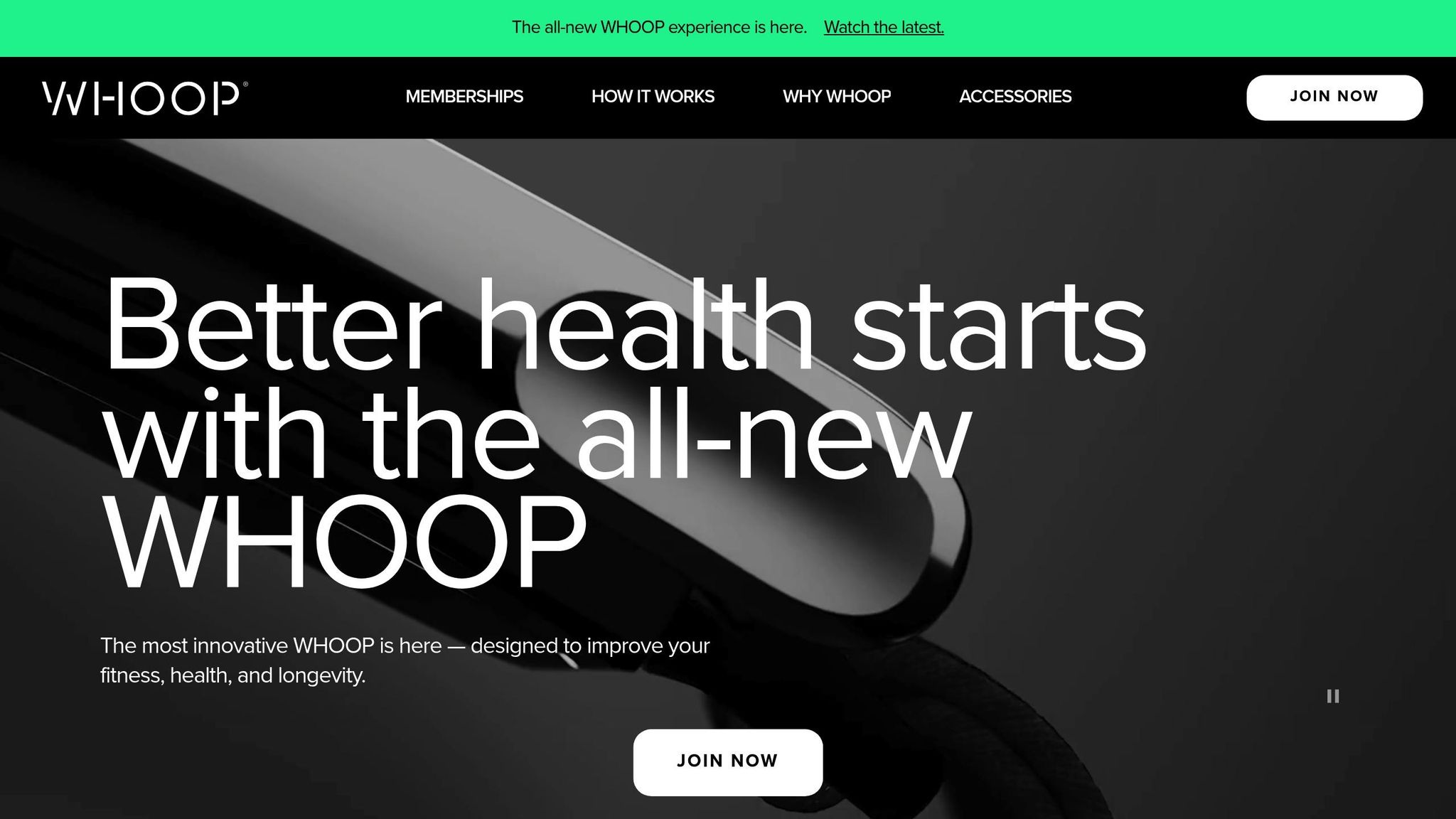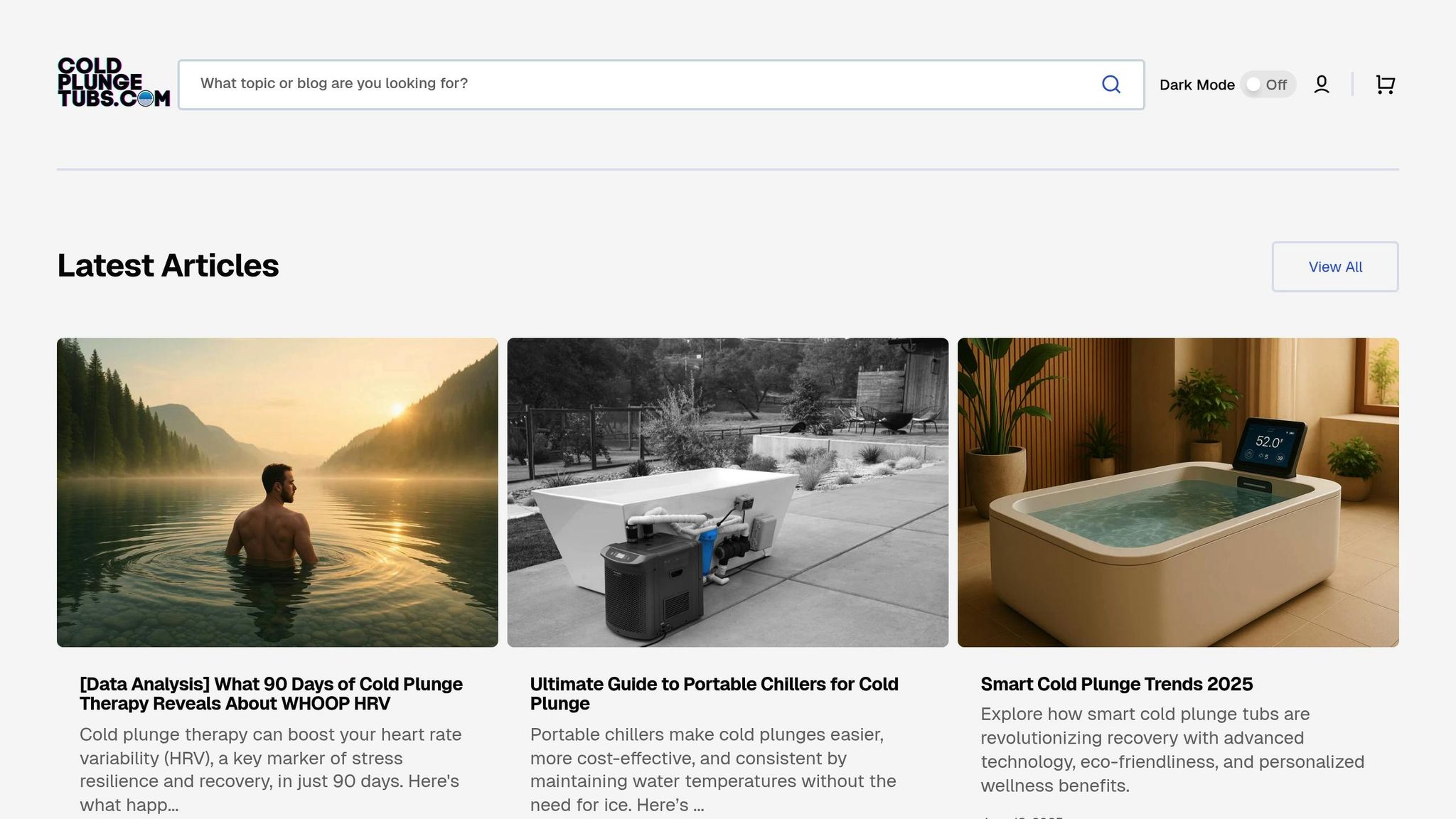Cold plunge therapy is gaining popularity for its ability to boost recovery and performance. By immersing in cold water (50–60°F) for just a few minutes, you can reduce inflammation, improve heart rate variability (HRV), and enhance sleep quality. Using a WHOOP device, you can track how cold plunges impact your recovery metrics like Resting Heart Rate (RHR), HRV, and strain levels over a 24-hour cycle.
Key Takeaways:
- Immediate Benefits (First 4 Hours): Boosts mood, lowers heart rate, and triggers recovery.
- Mid-Term Effects (4–12 Hours): Reduces stress, improves HRV, and stabilizes your body’s systems.
- Full Recovery (12–24 Hours): Enhances readiness, improves sleep, and lowers RHR.
Quick Tips:
- Timing: Use cold plunges within 30 minutes post-workout for best results.
- Duration: Start with 1–5 minutes and gradually increase as you build tolerance.
- Temperature: Stick to 50–59°F for optimal recovery.
- Tracking: Monitor metrics like HRV and RHR with WHOOP to measure progress.
Cold plunges are a simple, time-efficient way to recover faster, improve fitness, and feel better overall.
I Did Ice Baths for 30 Days - The Cold Plunge Protocol That Transformed my Sleep & Recovery!
WHOOP Recovery Metrics Explained

WHOOP monitors key physiological markers to show how cold plunges influence recovery.
Heart Rate Variability (HRV)
Heart rate variability (HRV) measures the time between heartbeats [4] and is considered a reliable indicator of physical fitness and readiness. WHOOP evaluates HRV using RMSSD, focusing on the balance of your autonomic nervous system. A higher HRV suggests better adaptability, while a lower HRV can point to stress.
Cold plunges can improve HRV by stimulating the vagus nerve, a critical component of parasympathetic regulation [5]. A 2019 study published in the Journal of Applied Physiology found that cold exposure increased vagal activity, which is directly tied to higher HRV [3]. However, the water must be cold enough to create a controlled stress response that strengthens your heart's adaptability [6].
As Jay Wiles, PhD, Chief Scientific Officer at Hanu Health, explains:
"Heart rate variability (HRV) is your ability to withstand and be resilient to the human stress response." [6]
HRV is highly personal, making it most useful to track your own trends over time rather than compare numbers with others. For example, the typical HRV range for 20- to 25-year-olds is 55 to 105, while for those aged 60 to 65, it's usually between 25 and 45 [4]. WHOOP is 99% accurate in measuring HRV [4], making it a reliable tool for tracking how cold plunges can improve autonomic resilience.
Resting Heart Rate (RHR)
Resting heart rate (RHR) provides another important recovery metric. WHOOP combines RHR with HRV, respiratory rate, and sleep performance to calculate your Recovery Score, which helps you understand how much physical strain your body can handle each day [4]. A lower RHR typically indicates better fitness and readiness, while a higher RHR may suggest stress or ongoing recovery.
Sleep Quality Measurements
WHOOP also analyzes sleep to give a fuller picture of recovery. It tracks all sleep stages - Slow Wave Sleep, REM, light sleep, and awake periods - to provide detailed insights [8][9]. The device calculates your sleep need based on factors like recent sleep patterns, daily strain, sleep debt, and naps. It also monitors wake events, sleep efficiency, and respiratory rate to offer personalized recommendations [8]. WHOOP’s sleep tracking is highly reliable, with 99.7% accuracy for heart rate and 99% accuracy for HRV during sleep [7].
| Sleep Metric | Optimal | Sufficient | Poor |
|---|---|---|---|
| Sleep Performance Score | 85%+ | 70–85% | <70% |
| Hours vs. Needed | 85%+ | 70–85% | <70% |
| Sleep Consistency | 80%+ | 70–80% | <70% |
| Sleep Efficiency | 90%+ | 80–90% | <80% |
| Sleep Stress | <1% | 1–5% | >5% |
WHOOP’s sleep insights help clarify how well your body is recovering, especially when paired with other recovery metrics.
Strain and Recovery Scores
WHOOP’s Strain and Recovery scores work together to show how your body manages and recovers from physical and mental stress. Strain measures how much cardiovascular and muscular effort you exert on a scale from 0 to 21, with the average daily strain for WHOOP users being around 11.0 [10]. Recovery evaluates your body’s ability to handle stress and suggests the optimal strain level for your day [11].
Cold plunges are a proven recovery method, as they activate the sympathetic nervous system (fight-or-flight) before engaging the parasympathetic system (rest and digest), which impacts heart rate and recovery [1]. Tracking HRV and heart rate during and after cold exposure provides real-time insights into how your nervous system adapts [3]. Over the 24 hours following a cold plunge, these metrics can highlight how your body rebalances and strengthens its stress response systems.
24-Hour Recovery Timeline After Cold Plunge
A closer look at the 24 hours following a cold plunge reveals distinct recovery phases, each offering unique benefits as your body transitions from stress to recovery.
First 4 Hours: Immediate Effects
The first four hours kick off with your body quickly shifting from an acute stress response into recovery mode. During this time, norepinephrine and adrenaline are released, setting the stage for recovery [3]. Within the first 30 minutes, your heart rate spikes before parasympathetic activation brings it back down, often dipping below your baseline levels [3]. Endorphins and other neurotransmitters flood your system, boosting mood and enhancing your sense of well-being [1].
For those tracking metrics like heart rate and heart rate variability (HRV), this is a critical window to observe changes using tools such as WHOOP [3]. These immediate physiological shifts set the foundation for the more sustained recovery benefits that follow.
4-12 Hours: Mid-Term Effects
As the initial effects settle, the next phase focuses on further stabilizing your heart rate and improving HRV. Research highlights that cold-water immersion is a powerful tool for stress reduction and overall well-being [13]. One study even found a substantial decrease in stress levels 12 hours post-immersion, with an effect size of -1.00 (95% CI: -1.40, -0.61, p < 0.01) [13]. During this period, cold exposure also aids in regulating body temperature and balancing the nervous system, which can significantly enhance sleep quality.
WHOOP data often reflects these changes, showing a steadier heart rate and improved HRV during this phase. However, timing plays a key role. Tara Cain, a researcher from the University of South Australia, explains:
"Cold-water immersion has been extensively researched and used in sporting contexts to help athletes recover, but despite its growing popularity among health and wellbeing circles, little is known about its effects on the general population" [14].
12-24 Hours: Complete Recovery Cycle
The final stretch of the recovery timeline, spanning 12 to 24 hours, is where the benefits truly solidify. WHOOP metrics during this phase often show enhanced readiness, with cold plunges ranking among the top recovery methods for boosting recovery scores [2]. Improvements in temperature regulation and nervous system balance contribute to better sleep quality, while elevated HRV and a lower resting heart rate signal that your body is primed for the day ahead.
For example, one Reddit user shared a dramatic increase in HRV, jumping from 40 to 100 after starting regular cold plunges [12]. Additionally, strain tolerance improves, as seen in WHOOP measurements that highlight a greater capacity to handle both cardiovascular and muscular demands [15]. Supporting this, a study involving trained swimmers found that daily cold-water immersion significantly restored HRV after intense exercise [3].
Cold Plunge Best Practices for Recovery
Maximize the benefits of cold plunge therapy by focusing on timing, temperature, and recovery techniques. WHOOP data highlights specific strategies to help you get the most out of your sessions.
When and How Often to Cold Plunge
To get the best recovery results, aim to immerse yourself in cold water within 30 minutes after a workout [2]. This timing allows your body to take full advantage of the physiological changes that occur as it transitions from exercise stress to recovery mode.
Cold plunges in the morning can also sharpen your focus and boost energy. Starting your day or preparing for a meeting with a cold plunge can elevate brain function, adrenaline, and catecholamine levels [16], making it a great choice for mental clarity.
Consistency is key. One individual saw their heart rate variability (HRV) rise from 16 to 75 and their resting heart rate drop from 72 to 55 beats per minute after committing to daily ice baths [6]. If you're new to cold exposure or tend to feel anxious, start with 4–6 daytime sessions before attempting evening plunges [17].
However, avoid cold plunges within an hour of bedtime or after late-night intense workouts, as they can interfere with your sleep [17].
Once you've established a routine, the next step is to focus on the ideal temperature and duration for maximum recovery.
Temperature and Duration Guidelines
The sweet spot for cold plunges is between 50°F and 59°F (10°C to 15°C) [16]. Interestingly, how cold it feels to you can be just as important as the actual temperature [6]. As Jay Wiles, PhD, Chief Scientific Officer at Hanu Health, points out:
"Heart rate variability (HRV) is your ability to withstand and be resilient to the human stress response" [6].
Duration also plays a crucial role. Research suggests that a 5-minute cold water immersion after exercise can counteract drops in parasympathetic activity and improve sleep quality [18]. Another study found that 15 minutes in 57°F (14°C) water helped participants return to pre-exercise HRV levels more quickly [17].
If you're a beginner, start with shorter sessions and gradually increase your time as your tolerance builds [5]. Colder temperatures can enhance HRV improvements, and even uncomfortable cold exposure can yield consistent results [6].
Cold plunges can also lower heart rate by 14 beats per minute, reduce breathing rate by 8 breaths per minute, and decrease ventilation by over 21 liters per minute [17].
Combining Cold Plunges with Other Recovery Methods
WHOOP analytics suggest that combining multiple recovery strategies leads to better outcomes. For example, member data shows that meditation improves recovery by +1% on average, massage therapy by +0.82%, stretching by +0.52%, ice baths by +0.41%, and breathwork by +0.29% [21].
Contrast therapy - alternating between hot and cold exposure - is another highly effective approach. About 30% of cold therapy users also incorporate hot therapy, which can further enhance recovery [19].
Cold plunges also pair well with mindfulness practices. They can reduce stress, improve circulation, support muscle recovery, and even boost flexibility and immune function [20]. These benefits make cold immersion an excellent complement to activities like yoga and meditation, enhancing emotional resilience and mood while deepening mindfulness practices [20].
As Brice Rothenberg from WHOOP explains:
"Recovery is essential to perform at your best, but knowing exactly what to do can be challenging" [21].
Using tools like the WHOOP app to track your recovery combinations can help you identify what works best for your body [19][21]. This data-driven approach ensures you're optimizing your recovery based on real metrics rather than guesswork.
Lastly, don't overlook hydration. Drinking 12 glasses of water a day has been linked to a 3% improvement in recovery [11], making it an easy and effective addition to your cold plunge routine.
Key Takeaways and Action Steps
Drawing from the detailed analysis of WHOOP data, it's clear that cold plunges can significantly enhance recovery and performance over a 24-hour period.
Main Findings from the Data
According to WHOOP data, cold plunges result in noticeable improvements in key recovery metrics within hours of use. For instance, one user reported a boost in heart rate variability (HRV) after just three days of combining cold exposure with sauna sessions [3]. Regular ice baths were shown to consistently improve HRV and lower resting heart rates, effects likely tied to increased cardiac vagal activity, which is linked to higher HRV scores [3]. Supporting this, a PubMed study found that daily cold water immersion helped trained swimmers restore HRV levels after intense exercise [3].
Cold therapy also seems to impact sleep quality positively, improving both deep sleep and REM cycles within the first 24 hours [3]. Additionally, strain scores drop faster, indicating quicker recovery times [3].
Interestingly, it doesn’t take much time to experience these benefits. Research indicates that just 11 minutes per week in water temperatures of 50–60°F can yield these results [22], making cold plunging a time-efficient recovery tool.
Practical Tips for Daily Use
- Track Your Progress: Log your sessions consistently and monitor heart rate and HRV before, during, and after cold plunges to understand your body's response [3].
- Start Small: Begin with 30-second to 1-minute sessions at 50–60°F and gradually increase to 5–10 minutes as your tolerance builds. You can also lower the water temperature over time, reducing it by about one degree each week [24].
- Focus on Breathing: Slow, controlled breathing at 5–8 breaths per minute during sessions can help activate your parasympathetic nervous system and manage the initial cold shock [24].
- Full Submersion: Immerse your entire body, including your neck, to stimulate the vagus nerve. If it becomes uncomfortable, briefly remove your extremities to regulate temperature [24].
- Timing Matters: For optimal recovery, schedule sessions within 30 minutes after a workout. However, if muscle growth is your primary focus, avoid cold plunges immediately after resistance training [23].
These practical steps can help you incorporate cold therapy into your routine effectively.
ColdPlungeTubs.com as Your Cold Therapy Resource

To make the most of these WHOOP-backed strategies, having reliable equipment is crucial. ColdPlungeTubs.com is a go-to resource for all things cold water immersion. The platform provides expert reviews, detailed comparisons, and practical guides to help you choose the right tub for your needs.
Whether your goal is faster muscle recovery, a stronger immune system, or sharper mental focus, ColdPlungeTubs.com offers trusted advice to help you make informed decisions. Quality equipment ensures precise temperature control and optimal conditions, making it easier to integrate cold plunges into your daily recovery routine effectively.
FAQs
How does cold plunge therapy improve heart rate variability (HRV), and why is this important for recovery?
Cold plunge therapy can boost heart rate variability (HRV) by activating the parasympathetic nervous system, often called the "rest and digest" system. This activation stimulates the vagus nerve, which helps the body relax, reduces stress, and supports recovery after physical or mental challenges.
A higher HRV is a strong sign of a well-balanced autonomic nervous system and greater stress resilience. In simple terms, it means your body can handle pressure more effectively, recover quicker, and maintain overall health. Adding cold plunges to your routine could be a valuable way to enhance recovery and support long-term performance.
What is the best time, temperature, and duration for a cold plunge to enhance recovery?
If you're looking to maximize the recovery perks of a cold plunge, try to keep the water temperature between 50-59°F and aim for a duration of 5-10 minutes. Many people find that the morning is an ideal time for this, as your core body temperature is naturally lower, which can amplify the experience. Of course, you can tweak these details based on what feels right for you and aligns with your recovery goals.
How can I use WHOOP data to track and improve my recovery after a cold plunge?
You can tap into WHOOP data to keep an eye on essential recovery metrics like heart rate variability (HRV), sleep quality, and strain levels after taking a cold plunge. If you notice your HRV going up and strain levels dropping, it's a good sign that your recovery is on track. Plus, monitoring your sleep patterns can help pinpoint the ideal timing for your next cold plunge.
By diving into these metrics, you can tailor your cold plunge routine to suit your needs - whether it's adjusting the length of time, the time of day, or the water temperature. WHOOP's detailed insights help you refine your approach, so you can make the most of your cold therapy sessions.
Related posts
- The Playbook for Increasing WHOOP HRV: A Data-Backed Cold Plunge Protocol
- [Data Analysis] What 90 Days of Cold Plunge Therapy Reveals About HRV
- Breaking a WHOOP Recovery Plateau: The Role of Strategic Cold Exposure

